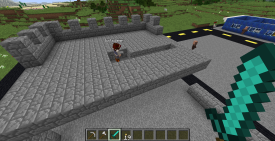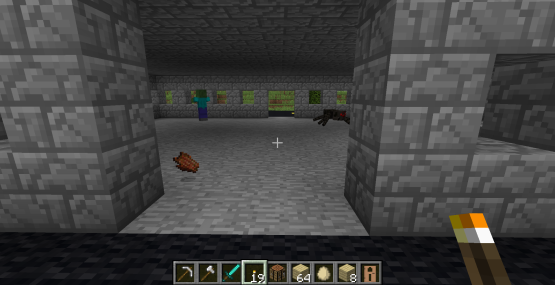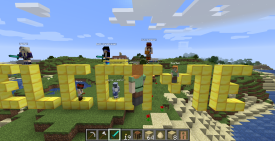Christine Richmond is a Robotics teacher at Peter Muhlenberg Middle School. Through a program facilitated by Carnegie Mellon University, Ms. Richmond’s eighth-grade students are constructing and programming Lego Mindstorm robots to navigate various courses and perform specific functions. Students work in teams to complete “challenge tasks” and demonstrate an understanding of various robotics engineering concepts. The students will ultimately apply what they have learned from the various tasks to complete a final challenge - programming their robots to act as emergency responders for search and rescue missions.
VSTE Voices
Educating Digital Citizens
In education, we require our students to take classes in civics and government, so they are prepared to be productive citizens. In the past decade, we have reached a near critical mass with the explosion of social media in our student’s lives. As a result, digital citizenship has become a consistent buzz word in our schools. We are tasked with the responsibility of cultivating 21st-century capable learners who are responsible, digital citizens worldwide.
Today our students are experiencing a time and type of exponential growth that we have never seen. Each day brings a new invention, a new social media, a new way to interact with the world. Yet the days of instructional manuals have long gone. When we were all unboxing our Nokia bricks in the late ’90s, they came with a manual that we read and reread. It was exciting when we learned that we could program different numbers. so we held down the number 3, and it automatically called mom. Fast forward 20 years and we unbox phones and just it.
Our students never had the instruction manual experience; they dive right in. We/They don’t read the terms of the agreement, we just check the box and start posting Tik Toks, tweets, DMing our friends on the Gram. We are training the first generation of students who no longer need us for information; they need us for an interpretation.
We might think digital citizenship is just for kids and teenagers, but the truth is there is no age too young for lessons. Adults need lessons on what exists, and kids all the way down to kindergarten can be given information, and a foundation on what being a responsible 21st-century digital citizen looks like.
No matter our generation, from Generation Z to Alpha, to generation X or Millenials, our communities are looking for instructional leaders to help them. They are looking for guidance on how to best navigate waters that we have just never been in. Trying to scare them away from social media hasn’t worked; we must mentor them. We must move beyond telling today’s students what not to do; we must join them. Brains are evolving and are processing differently than they used to. Toddlers know to swipe up on mommy’s phone when a notification appears while they are playing a game. They know to swipe a picture because in the ether on the outside of that picture (and the phone) is another picture for them to look at. Brains are changing, adapting, and so we must as well.
We have to understand that we are raising, educating, and bringing along a generation that was born with technology that we could have never imagined. Our students will interact with technology that doesn’t even exist because they are the generation who will invent it. They aren’t afraid of the internet, or wary of apps that are giving their data away. This is all they know. It’s not new, or scary, or dangerous - it is everyday life.
The big question today is what do we do about it? The biggest piece in this puzzle is us! We become overwhelmed because of the wave of technology and apps that come at us on a daily basis. We cannot hide from the hard conversations. We must take the lead; download the app, create an account, and see what it does. Research on Common Sense Media and discover the pros and cons.
Despite raising a generation of digital natives, we cannot assume they know everything. We have students who may have 5,000+ followers but don’t know how to attach a file or compose a professional email. It is our job to teach them, to train them, to go into classrooms and host neighborhood events that inform our communities.
Our students crave structure. Anyone who has been in a classroom for longer than a cup of coffee knows this. But this generation doesn’t often think about the structure they need or how to build it. That’s where we give advice, discuss rules, and set up systems. We must cultivate a healthy digital well being. To realize that safeguards, once explained, help all of us establish boundaries between our personal and professional lives. We need to explain that the people we text might be different than the people DM or let tag us online. Although we might feel uncomfortable with the environment, we know the difference between an online friend and a friend in real life. Our students need this understanding. There should be rules between an online friend and someone they follow online and/or someone who follows them. They want this structure, but they may not know how to ask for it. It’s our job to teach them more than just the difference between a stalactite and stalagmite, or how to graph a parabola, or when to use a semicolon.
It’s important to be reminded that we don’t teach subjects; We teach students.
Digital Citizenship Week is from October 14 to October 18, but it’s more than just a week. It’s a launchpointto start a lifetime of responsible Digital Citizenship. So we want to hear from you. We want to know what your advice is to our learners. What do you tell the people about through your social media? What do you share? Who do you share it with? And what do you watch out for? Let’s show people that, when used correctly, social media can be weaponized to give every person a voice. Let’s show people that we can start conversations and demonstrate leadership through the power of the internet. Scan or click the QR code to go to our Flipgrid and share your advice/vision/digital tattoo with us. Share it with everyone.
Written by Daniel Nemerow and Billy Watts from Prince William County.
Minecraft Monday
The first Monday of every month is Minecraft Monday. It happens at 8 PM Eastern time, in Maine USA. Unless that Monday is a holiday in the USA; then it’s the second Monday (like the Monday after Memorial Day in September, for example).
So on the second Monday in September 2019, at 8 in the evening on the eastern seaboard, USA, a group of miners, all educators from the looks of it, and mostly teachers of other young miners, met before bedtime for their monthly Monday play-date. By then I (Vance in Penang, Malaysia) was just waking up the following morning, Tuesday midnight Sept 10 UTC. So for me and folks in Europe and parts east of there, it’s Minecraft Tuesdays.
The event was announced by Kim Harrison (a.k.a. K4sons / Thunder in SL) as an informal discussion about ways to use Minecraft at school while building in the creative side of VSTE Place.
Basic directions to join VSTE Place, VSTE’s Minecraft world
To participate in Minecraft Mondays, you must have a computer Minecraft account from https://minecraft.net/en/. There is a one time fee of $26.95. Download and install the software. Choose multiplayer and add a server:
- Name VSTE Place IP 69.175.17.26:25565
- Our server is protected. You will need to be whitelisted to enter. For that, email Kim Harrison at K4sons@gmail.com from an educational email address with your real name and Minecraft account name.
Discord
Discord is a voice and screen sharing application that will run on your computer or mobile device. In order to talk with others in VSTE virtual environments, you need to download and install it for free. It helps us to be able to play Minecraft in one screen and listen via Discord with earbuds or headphones.
Create an account.
- Many of us use the same name for our Discord account as our Minecraft account to keep things simple.
- Our channel is https://discord.gg/nDX4mZv
Discussion and links from the group chat in Discord
Someone asked if people in the group were planning to use Minecraft with their students next term. I was quite surprised that one or two in the group answered in the negative, giving reasons of reduced funding for licenses and adequately powerful computers for students to use to run Minecraft, and poor to negligible technical and admin support, which again are additional symptoms of under-funding for staffing and overtime for after-school activities. If schools could fund creativity through increased staffing, it seems to me they would. It seems to me a step in the very wrong direction when a school system can’t support the efforts of teachers to integrate into their curricula something as creative and promotional of critical thinking as Minecraft. As someone else said in the chat, he thought you could teach anything in Minecraft. The point was discussed, and someone else pointed out the learning was in the discussion following the meaningful play, and that it takes a teacher with experience and the instincts to be able to convert game play into meaningful discussion, and from there into learning outcomes that jibe with the curriculum.
Again, this is just my opinion, but it seems to me that the nation has a crying need to be led by someone who can let the people’s elected congress decide where the money gets spent and stop draining it off arbitrarily (from schools, from disaster relief, from the military e.g. military schools) on pet, cosmetic, and ineffective partisan projects, and someone who would appoint as secretary of the Dept. of Education a highly qualified person who was passionate about and seriously attuned to education, not ignorant of its nuances, and who rose to her position only through her wealth and whom she had graced with it.
Anyway, it would have been unseemly to have raised all this in the chat, but I did mention that though I was not planning to use Minecraft with students this year, I was planning to use it with teachers, as I have done for the past five years, in the upcoming EVO sessions (Electronic Village Online, https://evosessions.pbworks.com). I invited those present to check our website (I say ‘our’ because two present at this event, Kim Harrison and Beth O’Connell) have been moderators of our EVO Minecraft MOOC sessions. I posted the URL for more information in the Discord chat, http://missions4evomc.pbworks.com/.
Speaking of discussion afterwards, as people were departing, I lingered to talk with someone named SunTzu about the comic books he was generating from his work with students in virtual worlds. Called Second Life Adventure Comics, SunTzu said he’d be “willing to do one for educators if we can come up with an interesting story narrative and visuals and hopefully have a purpose to use it”. See his work at https://sl-ac.weebly.com/

SunTzu uses Gyayzo to get the screen captures for his books, https://gyazo.com/f09ad6d02347442005b72ae974bda5e5. To read the books click on the links at top of the images that say SCAC 19-01, 02, and 03 (the book icons also appear hyperlinked, so clicking on just the text above the icons was not intuitive).
To visit SunTzu in world, follow this SLURL in Second Life
http://maps.secondlife.com/secondlife/Gulls%20Wing%20Marina/81/195/22
What happened on the day
Here are some of the screen shots I made while engaged in this event. There are more screen captures uploaded to the Discord chatroom for those who wish to talk with VSTE teachers.
Most of those present just started building, all in creative mode, with unlimited tools and resources at their disposal. We start with an overview taken from across the way looking back on where the building was taking place

And moving in closer as the building was getting under way
 Mainecakes made a turtle pond, complete with turtle she’d either spawned or lured there. Once done, she set about decorating the area with some of the plants available in creative inventory.
Mainecakes made a turtle pond, complete with turtle she’d either spawned or lured there. Once done, she set about decorating the area with some of the plants available in creative inventory.
K4sons set about making a saddlery shop. Some of the local mobs came around to have a look. I right clicked on one. I could have grabbed a few dozen lumps of coal from inventory and traded them with him for the emerald he had concealed under his cloak.
SunTzu and Beth_Ghostraven created a crenelated castle and when they moved to the second floor, the ground floor started attracting spiders and zombies, who tend to emerge during periods of relative darkness, such as rainstorms. In the screenshot below someone has slain a zombie and left its rotten carcass there for someone else to collect. If you accumulate such carcasses you can trade them with villagers for things you can’t find otherwise in Minecraft.
JazMar created something with impenetrable doors, so I had to catch him/her working with screenshots made through the windows. At one point a skeleton took up a position near one of the doors. He turned and faced me as I moved around him. However, as we were in creative mode, he did not attack. But then Beth appeared on the scene and took her sword to him. Before succumbing to that he got off an arrow that caught her on the bum. Ouch!
And when Dak arrived, he set about constructing one of his signature neo-monolithic structures. Asked how he could do it so quickly, he said he had done it so many times before. He is indeed a prolific and experienced builder. I followed him through the roof on the staircase leading to the ground floor, where I watched Dakotah making hasty improvements to the decor there, ignoring a llama and a neutered skeleton who had taken up residence downstairs.
I created my own monstrosity on a plateau behind where the others were building.
At the end of the day, we all gathered, as you do, for selfies and photos. There are more group photos in the Discord chat room. Those who are members can get there using this link: https://discordapp.com/channels/154391510064824320
Coming up at VSTE
Next week, in Second Life at VSTE Space we will talk about the books we read this summer.
Basic directions to join VSTE Space
If you don’t have a Second Life account, you can get one for free. We recommend setting one up at the Rockcliffe University Consortium’s Gateway here:https://urockcliffe.com/reg/second-life/ Here’s how
- Download and install the software.
- While your Second Life viewer (software) is open click this link http://maps.secondlife.com/secondlife/Soulgiver/155/144/58 and voila!
- Look for an avatar on VSTE Space and say, “Hey, I’m new!” We will take care of the rest.
We now have office hours every Saturday from 9 am to 11 am Eastern time.
http://maps.secondlife.com/secondlife/Soulgiver/155/144/58
Written by Vance Stevens and originally published on his blog, Learning2gether. It is reprinted here with his permission.
New Beginnings
The start of a new school year can be transformational for students and staff. New beginnings hold the promise of untapped potential: new connections, new experiences, new growth. How are we using technology to harness these opportunities for all students in our classrooms? Below are three key areas to explore this new year.
Empower student choice and voice
 August and September are perfect months to create strong class dynamics with student ownership. Use Google Forms to learn more about students (and parents!), providing an easy-to-use platform that can guide preferences, answer questions, and acknowledge concerns that others may be hesitant to share in person. One idea is to create an open-ended “What I Wish My Teacher Knew” form to be used throughout the year. You can adjust the settings on the spreadsheet to receive an email immediately when a form is completed. This will create a safe place all students can communicate with you in a timely, relevant manner.
August and September are perfect months to create strong class dynamics with student ownership. Use Google Forms to learn more about students (and parents!), providing an easy-to-use platform that can guide preferences, answer questions, and acknowledge concerns that others may be hesitant to share in person. One idea is to create an open-ended “What I Wish My Teacher Knew” form to be used throughout the year. You can adjust the settings on the spreadsheet to receive an email immediately when a form is completed. This will create a safe place all students can communicate with you in a timely, relevant manner.
Look for ways you can provide choice to students throughout the day. When creating assignments, can students select the order of completion or the quantity to complete? Choice boards, both digital and printed, enable students to discover their preferences in workload and provide practical time management skills as deadlines approach. Can students choose who they work with on collaborative projects? Do group projects provide flexibility in content, process, or product? Even small choices such as flexible seating and requesting songs for a class playlist uplift student morale.
Celebrate diversity
What makes our students unique are the same qualities that can propel them to greatness. Celebrate differences by having students respond to questions on Flipgrid, which allows them to share their thoughts while also listening to the diverse perspectives from other classmates. One idea is to create a “Would You Rather” topic where students provide classmates a choice between two options and responses can include a preferred choice with a brief explanation. With the new updates released this summer, students have more options for creativity and can even tap into the power of augmented reality, attaching their videos to items via QR code.
Students can also share stories about their diversity using digital writing platforms, interactive slide decks, and video compilations. Student-initiated passion projects are also powerful to shine a light on topics that matter most to our students.
Cultivate kindness
Every student in your class has the power to make the world a better place with their words and actions. Share conversations with students about the ways they build community, interacting with others both on and off the digital grid. Provide opportunities for students to practice respectful communication, whether through typed comments on a shared document or audio feedback on platforms like Seesaw and Flipgrid. Shine a light on the Sustainable Development Goals (SDGs) and encourage students to create innovative solutions for global issues that persist today. Make kindness a daily expectation as students learn more about empathy and compassion for others.
As we look towards a new school year, we are excited to see all the ways technology can be integrated into the curriculum to strengthen relationships and showcase student learning. We hope to see you at our annual VSTE Conference December 8-10, 2019 in Roanoke, VA where we will host more than 325 sessions and learn from inspirational educators including our Sunday Spotlight speaker, Tamara Letter, and Monday Keynote speaker, Michael Bonner. May your new beginnings spark unlimited impact!
Written by Tamara Letter, M.Ed. Tamara has more than twenty years’ experience in education as an elementary teacher, differentiation specialist, instructional coach, and technology integrator. She serves on the VSTE Conference Committee and won the 2018 R.E.B. Award for Teaching Excellence. Her first book, A Passion for Kindness: Making the World a Better Place to Lead, Love, and Learn was released in February 2019. Connect with her on Twitter and Instagram, through her Passion for Kindness Facebook group, or read more of her writing on her website.
Staying Ahead of the Game: 5 Quick Tips to Prepare for Next School Year
Summer is here! Well, almost. For many of us, Summer doesn’t begin in the middle of June, but anywhere from the middle to the end of May. Summer is a time for us to put away our lesson plans and start to work on our sun tans. But let’s face it, in about two very short months, we will be right back at it, engaging and enriching young minds that make their way into our classrooms. So how can we stay ahead of the game and be more prepared (and less rushed) when this restful season comes to end? Here are 5 quick tips (and by quick I mean hopefully they won’t take you long to accomplish) that you can do to prepare for next school year.
1. Organize your Cloud Storage
 Have you seen your Google Drive lately? If it’s anything like mine, the school year has not been kind to it and that digital space could use some tidying up. Take a few minutes each day (or a few hours on one day) and log into your favorite cloud storage and organize those homeless files. Make some folders, then some folders in those folders, and give those digital things a place to live other than the root of your storage. This is also a great time to color code and star some of your favorite files for quick and easy access (that is if the service allows for it).
Have you seen your Google Drive lately? If it’s anything like mine, the school year has not been kind to it and that digital space could use some tidying up. Take a few minutes each day (or a few hours on one day) and log into your favorite cloud storage and organize those homeless files. Make some folders, then some folders in those folders, and give those digital things a place to live other than the root of your storage. This is also a great time to color code and star some of your favorite files for quick and easy access (that is if the service allows for it).
2. Scan Those Printed Documents
If you have the rights to do it (please don’t go to copyright jail over the Summer), find a scanner or a scanner app and go to town making digital versions of your paper content. Some of my favorite scanning apps are Microsoft Office Lens, Tiny Scanner, and Adobe Scan. These apps make it so easy to scan and send digital versions of paper copies to the cloud. Oh, and when they get to the cloud, organize them per Tip #1.
3. Create Some Digital Quizzes
It only takes a few minutes to create a quiz in Google Forms, Quizizz, Kahoot, and all of those other awesome online quiz creators. Take a few minutes each week and make a quiz or two using your favorite online quiz service. The Fall Semester you will be ever grateful to the Summer Break you for having those quizzes ready to roll out on day one.
4. Make an Introductory Video, or ANY Instructional Video
If you haven’t ever used Loom, Hippo Video, YouTube Live or any of those other awesome online video makers, now is the time to start learning. Students LOVE video based learning. It gives them a greater sense of ownership over their educational experience and when you take the time to make videos of yourself reading off a spelling test, discussing derivatives, or simply welcoming those new faces to your class, you really bring your class to the next level of engagement, interaction, and overall awesomeness. Of all of these tips, this is the one I encourage you to try the most.
5. Take a Summer Break!
What? You thought this was going to be ALL about educational technology? Even the nerdiest of nerds (aka @nerdydad84) realizes that not everything can be solved by tech savvy integration strategies. Sometimes, most of the time, we have to go with what we know works, and summer break works. Take some time to live your life. Go somewhere you have never been, do something you have never done. Call an old friend. Make new friends. Spend time with the friends and family you have. Get out there and enjoy your summer because we only have a couple of months until we are back at it again.
Written by Daniel Vanover. Daniel has over 12 years of educational technology experience is a former high school Math teacher and currently serves as an ITRT for Wise County Public Schools. In addition to being a Google Certified Trainer and Apple enthusiast, Daniel is an avid hunter and enjoys woodworking and carpentry. Follow him on Twitter, subscribe to his YouTube channel, and check out his website.




























